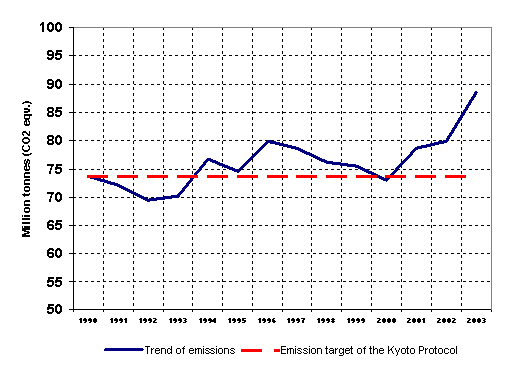25 November 2002
Inquiries: Ms Mirja Kosonen +358 9 1734
3543, mirja.kosonen@stat.fi
Director in charge: Ms Kaija Hovi +358 9 1734 2257,
kaija.hovi@stat.fi
Finland's national greenhouse gas reporting system becomes
established -
In 2003 Finland's greenhouse gas emissions exceeded by 20 per cent
the 1990 level
In 2003 Finland's greenhouse gas emissions totalled 88.5 Mt CO2 (million tonnes of CO2 equivalent). The emissions exceeded by around 20 per cent (15 Mt) the level for the year 1990, to which Finland should limit its emissions during the Kyoto Agreement's first commitment period between 2008 and 2012. This appears from the preliminary emission calculation data for the year 2003 compiled by Statistics Finland.
Methane emissions (CH4) have decreased by good one fifth from the 1990 level, which is due to improvements in waste treatment and contraction of animal husbandry. Correspondingly, emissions of nitrous oxide (N2O) have also diminished, which has been occasioned by reduced nitrogen fertilization of fields. In the last few years, the fast growing use of fossil fuels has contributed most to the increase in emissions, as Finnish energy producers have sold condensing power produced with coal and peat to domestic as well as to Nordic electricity markets. In 2003 greenhouse gas emissions caused by energy generation were 40 per cent higher than the corresponding emissions in 1990. Emissions from traffic have grown by just 5 per cent during the same period.
Greenhouse gas emissions in Finland in 1990-2003, Mt CO2 eqv.

Emission calculations are compiled by Finland's national greenhouse gas evaluation system, which is now starting its operation on a permanent footing. The national entity for the system is Statistics Finland, which is responsible for the production of annual emission calculations and the related methodological reports and for their submission to the UN Framework Convention on Climate Change and to the EU. The presently published emission data for the year 2003 will be reported to the European Commission once the results are confirmed by mid-January.
National greenhouse gas evaluation system is part of the Kyoto Agreement
The Kyoto Protocol obliges the countries committed to limiting their greenhouse gases to establish a permanent national greenhouse gas inventory system, which produces comparable monitoring data on compliance with the Kyoto Protocol obligations to both the UN Framework Convention on Climate Change and other parties. The description of Finland's greenhouse inventory system was handled in the Ministerial Workgroup on Climate and Energy Policy on 19 November 2004. Finland's greenhouse gas inventory system will be started on a permanent basis on schedule to the Government resolution, that is, by the end of 2004.
The greenhouse gas evaluation system comprises Statistics Finland as the national greenhouse gas inventory unit and the other expert organisations participating in the compilation, that is, the Finnish Environment Institute (SYKE), the Finnish Forest Research Institute (Metla) and Agrifood Research Finland (MTT). Co-operation with the ministries responsible for the climate policy is a fixed part of the evaluation system. The system and the connected agreements have been prepared in co-operation with the relevant organisations. During the preparation project Statistics Finland has improved its competence and the resources needed for implementing the system.
Strong competence and well functioning co-operation networks the bases for Finland's system
According to the Kyoto Agreement, national systems should be complete by the end of 2005, so Finland has been acting well in time. Other EU countries are currently preparing a corresponding system. The fast launching of the system has been possible in Finland because ground has been prepared for the inventory and the co-operation network has been created already before in the Ministry of the Environment's gas workgroup and in the Ministry of Trade and Commerce's committee on definition of public authority responsibilities.
The speedy starting and building of a reliable system have also been supported by connecting monitoring and reporting of greenhouse gases to already existing data sources and data collection processes. The system utilises the data produced by energy and environmental statistics, the data sources for monitoring agriculture and forestry and other information collected in public administration, such as plant-specific emission reporting for environmental permits and future emissions trading.
Source: Greenhouse Gas Inventory 2003. Statistics Finland
